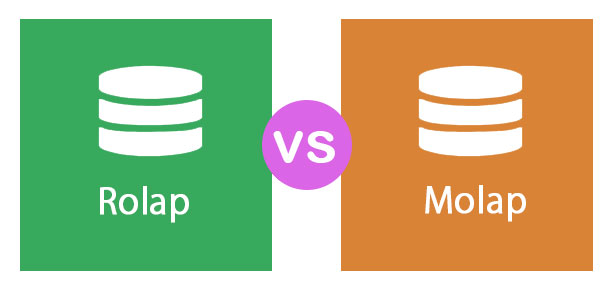Updated June 6, 2023
Difference Between ROLAP and MOLAP
ROLAP is a Relational online analytical processing where the data are stored in the form of tables, columns, and rows. MOLAP is a multidimensional online analytical processing, where data is stored in multidimensional formatted databases called ‘Data Cubes.’ As ROLAP allows all the relational data, there is no limit to the quantity of the data in this system. MOLAP allows only consistent, normalized data, and so the volume of data permitted in this system is restricted.
What is ROLAP?
It can handle a large volume of data using a relational database model. ROLAP lies between the front end and the back end of the system and stores each warehouse data efficiently.
Advantages of ROLAP
- ROLAP servers can easily be integrated with a relational database management system as it uses a relational database model.
- ROLAP handles a large amount of data efficiently
- DSS servers of Microsoft follow the ROLAP approach to handle data efficiently.
Disadvantages of ROLAP
- The speed of response to the query is small.
- There are some scalability limitations.
What is MOLAP?
MOLAP is a Multidimensional Online Analytical Processing. It creates data cubes to retrieve the data from multiple dimensions. To handle data, scattered matrix technology is used.
Advantages of MOLAP
- The speed of response to the query is high, helping the users connected to the network to analyze data better.
- Because of the Simple Interface, it is easy to use. Therefore compatible with both experienced and inexperienced users.
- It allows a faster index to the previously summarized data.
Disadvantages of MOLAP
- MOLAP does not contain detailed information about the data; hence it is compatible with those who need to handle detailed information about data.
- Storage utilization of MOLAP is low if the data sets are scattered.
Head To Head Comparison Between ROLAP and MOLAP (Infographics)
Below is the top 9 comparison between ROLAP vs MOLAP:
Key difference between ROLAP and MOLAP
Both are forms of OLAP. Let’s discuss some important key differences between them.
- ROLAP is a Relational Online Analytical Processing whereas MOLAP is a Multidimensional Online Analytical Processing.
- Data in ROLAP is relational. On the other hand, Data is hierarchical.
- ROLAP stores a large amount of data; however, MOLAP stores a limited amount of data and keeps summarized data in multidimensional databases.
- Both ROLAP vs MOLAP are stored in the main data warehouse, but the ROLAP stores and retrieves data From the main data warehouse, whereas MOLAP stores and retrieves data from the multiple dimensional databases.
- Relational databases store data in ROLAP, while array-based multidimensional data cubes store data in MOLAP.
- The relational database stores the data in ROLAP, enabling us to view it in real time. The database does not have a real-time connection with data cubes where data is stored in MOLAP; hence we need to update data frequently.
- The scalability of ROLAP Servers is more compared to servers in MOLAP.
- The speed of ROLAP’s response to queries is slow, whereas, in the case of MOLAP, the speed of response to the queries is faster than ROLAP.
- ROLAP uses complex SQL queries to retrieve the data from the Main data warehouse, whereas, in the case of MOLAP, it creates data cubes to retrieve the data from multiple dimensions. To handle data, MOLAP uses scattered matrix technology to retrieve the data.
- ROLAP dynamically creates a multidimensional view of data; MOLAP already stores data in the form of a multidimensional array in multidimensional databases
Comparison table between ROLAP vs MOLAP
Let’s discuss the topmost difference
| Objectives | ROLAP | MOLAP |
| Full form | ROLAP is a Relational Online Analytical Processing. | MOLAP is a Multidimensional Online Analytical Processing. |
| Amount of data stores | ROLAP stores a large amount of data | It stores limited data and keeps summarized data in multidimensional databases. |
| Source of data | ROLAP stores and retrieve data From the main data warehouse. | MOLAP stores and retrieves data from multiple-dimensional databases. |
| Form of data storage | It stores data in the form of a relational database. | It stores data in the form of array-based multidimensional data cubes. |
| Speed of response | The speed of response is slow | The speed of response is fast |
| Technology used | It uses complex SQL queries to retrieve the data from the data warehouse. | It creates data cubes to retrieve the data from multiple dimensions. To handle data, scattered matrix technology is used. |
| View of data | It dynamically creates a multidimensional view of data. | It already stores data in the form of multidimensional array in multidimensional databases. |
| Latency | Low | High |
| DBMS Facility | Strong | Weak |
Conclusion
Application and implementation of ROLAP vs MOLAP depend upon the complexity of data and performance of both models. The recommended option for storing large amounts of data is ROLAP, while MOLAP is suggested for those seeking faster processing. As ROLAP dynamically creates a multidimensional view of data, it processes data slower than MOLAP, which does not create a multidimensional view of data.
Recommended Articles
This has been a guide to the top difference between ROLAP vs MOLAP. Here we also discuss the ROLAP vs MOLAP key differences with infographics and a comparison table. You may also have a look at the following articles to learn more –




